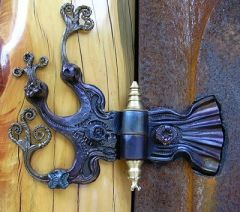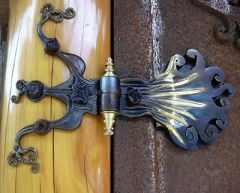
clang
Members-
Posts
58 -
Joined
-
Last visited
Content Type
Profiles
Forums
Articles
Gallery
Downloads
Events
Everything posted by clang
-
Dragging a file backwards only is bad on hard metals. Sharpening with acid helps a dull file, but the teeth will be uneven and have a shorter life. To remove "pinners" from a file, make a file pick from soft iron ( preferably pure iron). The best one i've used has a looped handle and a crowned, flattened blade. With edges sharpened, the end of the file pick is cut on a diagonal and sharpened to about 60*. Don't let sharp files grate together. Clang.
-
Most folks don't move their hand in a straight line as they stroke..also they tend to rotate their wrists. Moving in a straight path helps a whole lot...clangue
-
There's some liquid skin stuff the basketball players use to add tough layer over tender skin. Holding the hammer too tightly will contribute. Tennis elbow...don't push it..it can become chronic and the devil to get rid of! Go to a lighter hammer till the pain stops. Lift palm up, not back of the hand up...roll your hand around the handle some so that the back of your hand isn't on top of the handle..same is true for all forearm lifting till the tendon heals. Use the rebound of the impact to assist starting the hammer lift , but keep the butt low until the hammer head is nearly vertical over your hand before you lift the whole hammer close to your body. This trick will allow you to swing a heavier hammer. Keep your elbow tucked in. Shift to progressively lighter hammers as you tire. That helped me a lot...Clang
-
Grant: 25 or 30 years ago i built a pop-up-torch using a Smith gas saver on a stand. Took a while and a lot of fiddling around, but i've been using it ever since and i can still get parts. The rig was foot pedal actuated, causing the torch to rise, turn the gas on, sweep past the pilot lite and rise to a convenient position. The torch was mounted in a cradle with thumbscrew adjustable positioning joints, on top of a flat shaft. The flat shaft has a 1/2 twist and runs through a guide slot welded to the stand. Near the bottom of the flat shaft is a swivel joint that allows the shaft to rotate along it's length. At the bottom of the flat shaft is an elbow joint that connects to the foot pedal with a fulcrum point inbetween pedal aqnd elbow. Next to the torch cradle ,atop the flat shaft, is a clip that holds the linkage chain that runs up to the lever arm on the gas saver to turn the gas on and off as the flat shaft rises and falls. So, when i step on the pedal, the far end of the pedal bar rises (fulcrum) and lifts the flat shaft and swivel joint, which forces the 1/2 twist through the slot causing the torch cradle and torch above to rise and pirouette so the torch tip sweeps across the pilot light just after the linkage chain opens the gas saver valves...leaving me with a lit torch, ready to go. There is an adjustable soft firebrick on an arm that can be positioned a few inches from the lit torch for quicker, more even heating. Clang Peter Fels, Phoebe Palmer:artists
-
What no one will tell you, is for many folks, especially with essential tremor, a shot or 2 of booze will help damp the movement. Triangulate your bracing and pivot on the brace.
-
Keltoi: If you have an area near the center of the face of 1 or 2 Sq inches that's pretty clean, that's all you really need. Most actual forging takes place in that small an area. A 4" belt sander will clean up the surface rust. Just using an anvil will slowly work the lumps towards level and as a new smith you will probably add a few dings of your own. Make a stake with a hard polished surface for when you need it, same with square corners. Welding on an anvil is a dead last resort and usually a mistake for several reasons. If you are forging machine tool parts, a smooth face is important. But things that are hand forged should show it and those anvil face dings make for "validating surface information" ( a good thing)..IW
-
What can you see outside of your shop?
clang replied to chyancarrek's topic in Blacksmithing, General Discussion
A 700' drop to the Pacific ocean, but right now we are fogged in ,as we often are, and i can't see across the yard. -
There are a couple of multistep methods Firegirl, but they are a nuisance. I read a 1930s method than ran to 13 layers and another , later one that ran 7 layers. There is, or was, an AC aluminum-bronze rod that will deposit on freshly scraped aluminum and an AC phos-bronze rod that will lay down on that ,as well as steel. A little tricky but possible...pf
-
Wim; I think you will find the large radiuses on the far side of your anvil are very useful indeed. I use mine with a cross peen for drawing all the time. clang
-
Moving Heavy Stuff...what to buy in what order
clang replied to Matthew Groves's topic in Shop Tips n' Tricks
mid quality come-a-longs are a great help..get several and gang them up if necessary. 6013 offering is excellent. Pipe rollers will allow a single person to move real tonnage quietly. A collection of pipe rollers is a must. If you have weight across irregular surfaces, overlapping pieces of plywood are a big help. A collection of timbers and planks is good for loading and unloading. Whenever you move heavy stuff, stop and consider all possible accidents and complications. Figure out ahead of time how to prevent them and where to jump. Always lay out your escape routes ahead of time........Clang -
Denny; In many cases, the older machines are far more durable than the new cheapies.
-
Fredly; You did the right thing by not welding on it. Way too many usable anvils have been ruined that way........Clang
-
Hi Thomas; I've tried that on other hollowbodies , ala Elizabeth Brim, tried water pressure too. It doesn't work as well as i imagined. I've also tried spot heating a low spot while the vessel was under pressure ( hairy) and that wasn't very successful either. This piece is pretty complex and has sections of varying thicknesses and compound curvatures, and it isn't completely closable. Irnsrgn; Neat! Never heard of that. I'll try it. Is it just for slight dents or will it work on more severe ones? How hot do they get it? Any idea of the mechanism behind why it works? There was a guy selling a system that used rare earth magnets on the outside and round hardened steel balls inside to iron out the dents on brass musical instruments..but that's a thin, softer metal. Wonder if i could do the same thing with an electro-magnetic dolly and a foot switch? Clang
-
When i first moved into the old shop near Piedras Blancas Lighthouse, Clarence, the old cowboy hobbled into the yard and introduced himself. Asked if i'd known the Evans boys who had grown up there. I said i hadn't. Clarence said, "well, the younger boy was about 21, on leave from the army, when he drained the water out of an old rusty 55 gallon drum and started to cut the top off with a torch." Then Clairance sort of squinted and half grinned and said..." Bleeeew 'is head clean off 'im!" And peered at me like he was real interested in seeing it repeated.
-
Having used some really nasty stuff for quench oil, including PCB laden transformer oil ( worked real well!) and lots of drain oil...i'd say, go for deep-fry oil. When it starts to go rancid, either trade it in or cover it up and wait a few months. However, rancid quench oil and a big glowing bar of steel will rid your shop of gawkers, wives and tourists pronto.
-
i tried multiple coats of Future acrylic floor wax over linseed oil on some outside hinges...lasted about 4 months...Clang
-
I'm going a little nuts trying to figure out a way to remove dents from a 14 Ga welded steel hollowbody. It's all closed up so i can't get tools inside. Everytime i heat an area, adjacent areas distort. If a torch is used to weld over the low spots, new low spots appear right next to the spot. If a rod is welded to the low spot, which is heated and pulled, it makes the immediate area better ( except for the nipple formed) but the warpage in the adjacent area gets worse. When a nearby high spot is tapped down, the HAZ next to the weld is annealed and subsequently sinks more than the high spot. When the weld is ground flatter, thin spots are formed which distort when anything near them is heated. OK , I'll admit it...i was pretty nuts to begin with, but what i'm doing isn't helping...any ideas? Clang
-
-
-
We've mostly talked about air movement and personal effects but how you build your shop is important too. High ceilings are fine in the summer and doggy to heat in the winter. Good venting up high helps a lot, heat rises. A shop built with a reflective outside shell, and an insulated liner also is beneficial. If you add a lot of thermal mass inside ( steel works excellently) then the shop will heat up a lot slower. At night, when it's cooler, open up the shop to cool the thermal mass down as much as possible. Water stores a lot of heat or coolness for it's volume. A big tank that you can shield from the sun and expose to the night sky can make real difference. In the winter you reverse the exposures. When we have a big heat wave i set a rainbird sprinkler on the shop roof and turn it on for a few minutes every hour. Kinda interesting how many blacksmiths and welders have also been firemen. Guess not all pyromaniacs go to jail after all.

